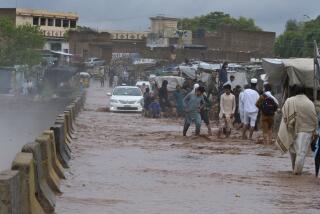Cyclone Phailin pounds eastern India
NEW DELHI — India was battered by a massive cyclone Saturday as more than half a million people in vulnerable coastal and low-lying areas spent a terrifying night in shelters amid power outages, large storm surges and canceled train trips and flights.
With roads blocked and communication down in many areas and the full extent of the damage still unknown early Sunday, news organizations reported that few people had lost their lives, most from flying trees and debris. The early death toll was five to seven.
Officials said Cyclone Phailin affected 12 million people in the eastern states of Odisha and Andhra Pradesh as wind speeds hit 132 mph and ocean surges topped 11 feet. Communities reported large numbers of houses, warehouses and businesses destroyed by the rain and high wind.
PHOTOS: India battered by massive cyclone
According to some reports, more than 700,000 people were moved out of the most vulnerable area, making this India’s largest evacuation in nearly a quarter of a century.
“This is one of the largest evacuations undertaken in India,” M. Shashidhar Reddy, vice chairman of the National Disaster Management Authority, told reporters in the capital, New Delhi. “Our priority is to minimize loss of life.”
On landfall, the cyclone was gradually losing strength. The affected region was expected to see intense rain and some wind for the next 24 hours.
“India braces for Phailin fury,” said one TV headline. “India’s Katrina,” flashed another.
Television showed large waves battering the shore, wind-wrecked palm trees, concrete power and cellphone towers snapped, cars upended and communities in the dark as people emerged from their homes to start the recovery stage.
In many areas, Muslims and Hindus crowded mosques and temples in the hours before the storm hit to pray that Phailin would not match the damage of a storm in 1999 in Odisha, then known as Orissa, that killed about 10,000 people.
Key differences between the two storms appeared to be better preparation and more organized evacuations this time, as well as the storms’ relative trajectories. While its counterpart 14 years ago hugged the coast, which allowed it to continue drawing strength from the sea, Phailin moved inland, losing strength.
In the hours before its arrival, hundreds of people lined up at gas stations, grocery stores and automated teller machines in Bhubaneswar, the capital of Odisha, as the storm approached.
“The state has been in panic mode,” television researcher Sahashranshu Mohapatra said by telephone.
The Indian government has not had a great record in crisis management, but officials appeared to draw lessons from earlier disasters, positioning cargo planes, helicopters and naval vessels in advance, placing divers and 10,000 soldiers on alert and assembling hundreds of thousands of food packets should they be needed. There were a few sporadic reports Sunday of shelters so full or badly built that people were forced to spend the night under eves.
The task of evacuating such a huge number of people was compounded by some who refused to leave their homes. “Because Odisha is prone to cyclones, they were under the impression that it won’t be severe,” said P.K. Mohapatra, Bhubaneswar’s special relief commissioner.
“We’re on top of the situation,” he said, “as much as you can be in such situations.”
Many homes in the area are made of mud or basic materials, so the number of homeless people could prove large.
Messages posted on Twitter reflected the fear and concern of many Indians. “#CyclonePhailin is like a powerful uninvited guest coming to ruin a family. Prayers!!” said user @rupakpal.
Some weather forecasters compared the cyclone’s size and intensity to Hurricane Katrina before it landed. That storm battered the U.S. Gulf Coast and caused catastrophic flooding in New Orleans in 2005, killing about 1,800 people and resulting in an estimated $110 billion in property damage, a comparison that didn’t bear out.
The Bay of Bengal where the storm emerged, at one point reaching the size of half of India, has seen its share of storms. Jeff Masters, founder of Weather Underground, a forecasting service based in Ann Arbor, Mich., wrote in his blog that 26 of the 35 deadliest tropical cyclones in recorded history have been Bay of Bengal storms.
Greenpeace India expressed its concern for victims of the cyclone and warned that average global temperatures would continue to rise, causing more intense tropical storms in some regions, unless greenhouse gas and global warming are addressed.
“The climate change ball is rolling and people will suffer the consequences,” Biswajit Mohanty, a Greenpeace India board member, said in a statement.
More to Read
Start your day right
Sign up for Essential California for news, features and recommendations from the L.A. Times and beyond in your inbox six days a week.
You may occasionally receive promotional content from the Los Angeles Times.






